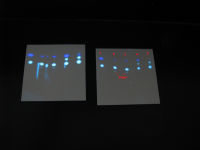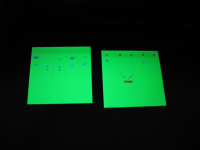TreehouseChemist
Lost Soul
Hello! Long time reader, first time poster.
I have been making extracts of peganum harmala for about 7-8 years now, and in the last couple years I have gone the extra step of separating and crystallizing the individual alkaloids, and I have some test results I could use some extra input on.
My extraction procedure: Make P harmala tea (usually 3kg of seeds at a time in a giant stainless steel cooking pot (from academy, normally used for boiling the hell out of dead animals). Precipitate with lab grade NaOH, redissolve with distilled vinegar, filter through lab paper with vacuum, NaOH precip, repeat 3-4 times. Redissolve in vinegar, filter, get it up to boiling temperature, add salt (Manske), let xtals crash out over a day, filter and dry, redissolve in vinegar, heat&salt&crash again, filter, add base until the brownish alkaloids fall out, filter those out, add more base to get the orangish portion (a large portion of the alkaloids, believed to be harmine), filter those out add more base till the precipitate begins to turn white, filter that portion out, then crank the pH up to 13 and white (with maybe a hint of pink) precipitate falls out (the 2nd largest portion, believed to be harmaline). I then take the individual harmine and harmaline portions and run through a couple more Manske cycles, save some as HCl, and base precip the rest to get the freebases.
I have been working with HPTLC plates (looking for fluorescent compound in wild mushrooms) for the last few months, and decided to run my harmala extracts through a plate to see how well the separation works. Here are the results.
1. The un-separated alkaloids (full spectrum after Manske). Surprisingly, this only had 2 spots on it.
2 & 3 harmaline reduced with zinc to produce THH.
4. Orange harmine fraction.
5. White harmaline fraction.
2& 3 have a spot with a lower rf than any of the others, but I don't know the rf of THH so I can't say for sure that it worked.
I think that the purple spots are harmine (based on the fact that the harmaline sample has a very light purple spot, and the harmine sample has a bigger/brighter spot).
Questions: Has anyone done this and identified the individual spots? Does anyone have the relative rf values for the different harmalas? Why do the separated alkaloids have an additional spot in the middle, while the mixed alkaloids don't? The separated alkaloids were made from the mixed alkaloids, so perhaps something that was created during the separation process? Whatever it is, the zinc reaction made it disappear because lines 2 & 3 were made by mixing #5 with zinc.
Any input would be much appreciated. I am trying to improve my separation technique but don't have access to HPLC or MS. I will hopefully be running GC (no MS) next week and will post the results. Thanks!
I have been making extracts of peganum harmala for about 7-8 years now, and in the last couple years I have gone the extra step of separating and crystallizing the individual alkaloids, and I have some test results I could use some extra input on.
My extraction procedure: Make P harmala tea (usually 3kg of seeds at a time in a giant stainless steel cooking pot (from academy, normally used for boiling the hell out of dead animals). Precipitate with lab grade NaOH, redissolve with distilled vinegar, filter through lab paper with vacuum, NaOH precip, repeat 3-4 times. Redissolve in vinegar, filter, get it up to boiling temperature, add salt (Manske), let xtals crash out over a day, filter and dry, redissolve in vinegar, heat&salt&crash again, filter, add base until the brownish alkaloids fall out, filter those out, add more base to get the orangish portion (a large portion of the alkaloids, believed to be harmine), filter those out add more base till the precipitate begins to turn white, filter that portion out, then crank the pH up to 13 and white (with maybe a hint of pink) precipitate falls out (the 2nd largest portion, believed to be harmaline). I then take the individual harmine and harmaline portions and run through a couple more Manske cycles, save some as HCl, and base precip the rest to get the freebases.
I have been working with HPTLC plates (looking for fluorescent compound in wild mushrooms) for the last few months, and decided to run my harmala extracts through a plate to see how well the separation works. Here are the results.
1. The un-separated alkaloids (full spectrum after Manske). Surprisingly, this only had 2 spots on it.
2 & 3 harmaline reduced with zinc to produce THH.
4. Orange harmine fraction.
5. White harmaline fraction.
2& 3 have a spot with a lower rf than any of the others, but I don't know the rf of THH so I can't say for sure that it worked.
I think that the purple spots are harmine (based on the fact that the harmaline sample has a very light purple spot, and the harmine sample has a bigger/brighter spot).
Questions: Has anyone done this and identified the individual spots? Does anyone have the relative rf values for the different harmalas? Why do the separated alkaloids have an additional spot in the middle, while the mixed alkaloids don't? The separated alkaloids were made from the mixed alkaloids, so perhaps something that was created during the separation process? Whatever it is, the zinc reaction made it disappear because lines 2 & 3 were made by mixing #5 with zinc.
Any input would be much appreciated. I am trying to improve my separation technique but don't have access to HPLC or MS. I will hopefully be running GC (no MS) next week and will post the results. Thanks!


